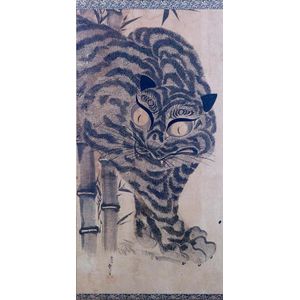Hokusai School Tiger Scroll Painting
You must be a subscriber, and be logged in to view price and dealer details.
Subscribe Now to view actual auction price for this item
When you subscribe, you have the option of setting the currency in which to display prices to $Au, $US, $NZ or Stg.
- Edo Period, Japan - The Edo period in Japan lasted from 1603 to 1868. During this time, Japan was ruled by the Tokugawa shogunate, a military government led by the Tokugawa family. The Edo period is characterized by a period of relative peace, stability, and economic growth, as well as by the development of a distinctive culture and society.
During the Edo period, the capital of Japan was moved from Kyoto to Edo (modern-day Tokyo), and the country became increasingly isolated from the rest of the world. The shogunate implemented strict policies to maintain control, including the restriction of foreign trade and travel. However, despite this isolation, the Edo period saw significant cultural and artistic development, including the emergence of the ukiyo-e woodblock print tradition, the growth of Kabuki theater, and the flourishing of a vibrant merchant culture.
The Edo period ended with the Meiji Restoration of 1868, which saw the collapse of the shogunate and the restoration of imperial rule. - School of .... - In the opinion of the cataloguer, a work by a pupil or follower of the artist.
This item has been included into following indexes:
-
Japanese art
- painted scrolls 51
- paintings 105
- woodblock prints 627
Visually similar items

A Kirman prayer rug, Southern Persia, circa 1900, finely woven depicting the garden of paradise with exotic birds and animals in intertwining branches above ponds and ducks, surrounded by a pale blue border of birds and blossoms, 200 cm long, 140 cm wide

A William IV linen cross-stitch needlework sampler, English, 19th century, worked by A. Jackson and dated 1835. 33 cm high, 33 cm wide

Map, in Notitiam Ecclesiasticam Africae. Map of Spain, Eastern Mediterranean and north Africa by Philippe Buache, pub. Paris 1745. Hand coloured copper engraving. 49 x 64 cm

A Burmese tribal witch doctor's outfit, jacket, square head cover and magic square placed in front of diviner.
